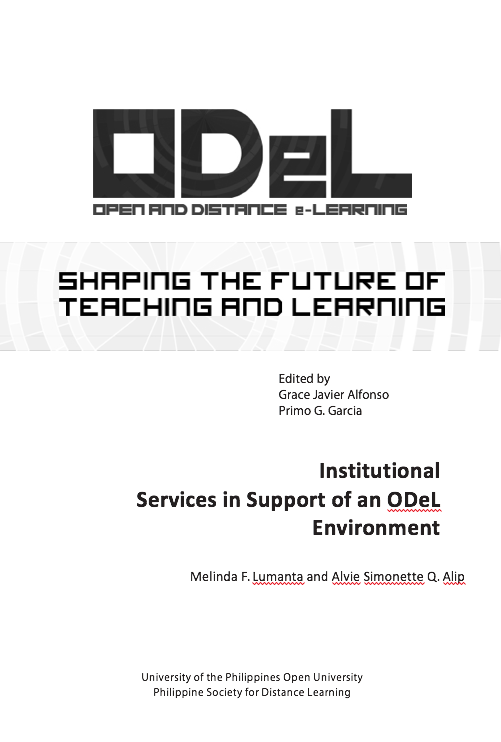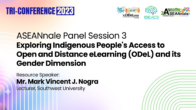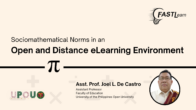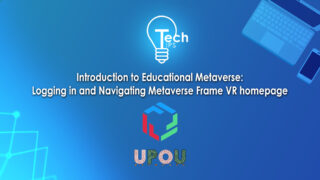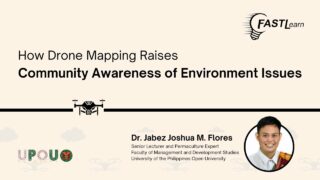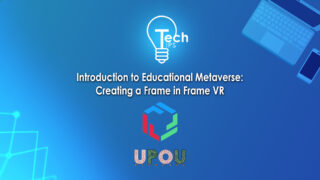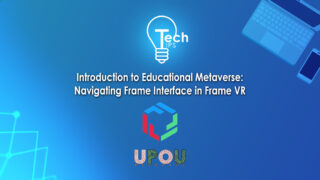When in 2010 the UP Open University (UPOU) embarked on being an open and distance e-learning (ODeL) institution, support systems were put in place to enable a networked and technology-based learning environment. ODeL initiatives of the university had and continues to be supported by UPOU’s two main staff offices—the Office of the Vice Chancellor for Academic Affairs (OVCAA) and the Office of the Vice Chancellor for Finance and Administration (OVCFA).
With a clear mandate to be 100% online, the academic and administrative functions of the university were reoriented to suit the so-called 4th and 5th generations of open and distance learning wherein web-based materials and the use of a learning management platform figure prominently. It was a move from a paradigm using primarily print-based learning resources with face- to-face tutorials and variations of it (Generations 1-3) to one that relied on web technologies (Generations 4 & 5). The shift in its core academic philosophy created a ripple effect on UPOU’s finance and administrative operations.
Innovative strides in the academic realm reflect adaptation, if not radical changes, in perspectives, pedagogies, and practices in ODeL in UPOU. It is notable that, after a decade of using print modules, UPOU switched to digital copies which were downloadable and printable. Students initially accessed these through a virtual bookshop which served as a repository of course modules; later, it was decided that a decentralized system was more efficient. Digital copies of the material were uploaded to course sites accessible to enrolled students. The leap from print to digital formats of course materials not only redefined course delivery and course development (from printed module to resource-based course package) in UPOU; it likewise refocused certain functions in the administrative support systems.
In the academic realm, the major changes were accompanied by evolving student support systems. Figure 1 shows the timeline of the UPOU support units under OVCAA from 1995 to 2013. The reorganization in UPOU that happened in 1998 and 2003, and the rapid developments in the use of information and communication technologies (ICTs) and Internet in higher education brought academic and administrative changes in how the UPOU support units operate, particularly in course delivery and course development.
Figure. 1. UPOU Support Unit Timeline from 1995 to 2013 (Alip & Yambao, 2013)
In its early stage, the delivery of UPOU’s academic programs was through distance education using stand-alone printed modules supplemented by audio-visual materials, and a once a month face-to-face tutorial session. With the advancement in computer technologies and the Internet, UPOU adopted online teaching and learning in 2001 via the Integrated Virtual Learning Environment (IVLE), and in 2007 offered its courses online via the Modular Object-Oriented Dynamic Learning Environment (Moodle). UPOU also started its own massive open online courses (MOOCs) in 2013. With such developments, UPOU maximized the potentials of ODeL in making quality education more accessible, enhancing the learning experience of its students. For instance, UPOU customized its own learning management system, MyPortal, which is also powered by Moodle, for greater support to teaching and learning.
Aside from MyPortal, another major innovation in student support was the development of the Online Student Portal (OSP), a student facility of the academic information management system (AIMS). OSP is the online gateway of UPOU’s academic operations wherein “students can register online, view their final grades, pay online, request for documents, view important announcements, and access the online course sites, e-library resources, online order system for learning materials, and student evaluation of teacher” (Secreto & Pamulaklakin, 2013). UPOU is also targeting system integration and rationalization as it continuously develops other online systems that will make teaching and learning in the digital age more interactive and productive, efficient, and effective.
The offering of online courses expanded UPOU’s reach to offshore students located in more than 40 countries. This increase in the number of offshore students eventually paved the way to establish the Virtual Learning Center (VLC) for offshore students with a full- time coordinator in 2011.
The effects of the shift in UPOU’s core academic philosophy were also felt in the finance and administrative sector. As the administrative sector kept pace with the innovations in the academic sector, initiatives on computerization of operations, development of online payment schemes, and installation of ICT infrastructure were taken on as new challenges of the university. As an agile organization, UPOU was in a position to experiment with these innovations even as it remained part of the University of the Philippines (UP) System of conventional campuses.
As early as 2001, the OVCFA embarked on the production of an e-Manual in anticipation of an ODeL environment. A computer- based compilation of processes accessible through UPOU’s intranet, the eManual was intended to guide UPOU staff and various UPOU clientele in understanding and complying with applicable government rules and regulations that govern the operations of the university.
It started with a soul-searching undertaking that examined the administrative processes of the university and attempted to use the affordances of a digitized system. For instance, UPOU recognized its unique situation as an open university. “Consistent with the nature of an open university where the students could enroll and graduate without ever having to set foot in a physical campus, the OVCFA focused its efforts on studying, proposing and implementing payment schemes that would allow students to perform school- related transactions through alternative modes” (UPOU, 2007).
In addition to online and over-the-counter payments through local banks, the Learning Centers and Cash Office at the UPOU headquarters, a wide range of payment options including credit card payments for local and foreign students using over-the-counter (OTC), mail-order-telephone-order (MOTO), and e-Commerce modes were instituted by the university. UPOU had in mind a system that would be a clear-through process whereby its online and regular registration could be complemented with an online payment scheme suitable for open and distance learning students.
With support from the UP administration, UPOU was first among the campuses to implement credit card payment of tuition fees by the students. Moreover, with an internet payment gateway facility in place, UPOU is positioned to handle other transactions vital to student support services and its own internal operations.
The UPOU’s strategic position as the academic leader in ODeL in the country and in the region requires that its support units be proactive, innovative, and creative in ensuring quality academic offering, engendering a culture of innovative research in ODeL and the disciplines, modernizing ODeL pedagogy, mainstreaming open educational resources (OER) advocacy, and strengthening instructional and student support services (OVCAA, 2013). Needless to say, the main support offices of the university have to confront and creatively address issues and challenges in student support systems for online teaching and learning.
Articulated as directions the university intends to pursue, these challenges are in the areas of student support resources, online examinations, and assessment systems for massive online courses. Alfonso (2013) articulated these in her speech before distance education leaders. First, student support resources (e.g., academic policy manuals, academic calendars, FAQs, learning strategies) need to be readily accessible. Second, ways by which online examinations can be delivered effectively and efficiently should be explored. An open source invigilating system can be developed, one that ensures security and integrity of examination and can cover different sources of assessments. Third, the foray into MOOCs questions the very nature of support. An assessment is needed to identify the extent and form of support that can be replicated on a massive scale in online courses.
Adhering to its being a learner-centered university in an ODeL environment, UPOU will continue to evolve as it adjusts its institutional systems and structures in accordance with the varying and changing needs of its learners.
Alip, A. S. Q. & Yambao, Y.I.A.M. (2014, January). Openness: What it means to the UPOU support staff. Paper presented at the International Conference on Open and Flexible Education, Hong Kong.
Office of the Vice Chancellor for Academic Affairs, UP Open University. (2013). Ensuring access and equity to quality 21st century UPOU education, tomorrow and today: The OVCAA’s contributions, 2010-2013. Los Baños, Laguna, Philippines.
Secreto, F. & Pamulaklakin, R. (2014, January). The Online Student Portal: A learner support in an ODeL environment. Paper presented at the International Conference on Open and Flexible Education, Hong Kong.
UP Open University. (2007). The growth years: 2001-2006. Los
Baños, Laguna, Philippines.
Suggested citation:
Lumanta, M. F. & Alip A. Q. (2014). Institutional Services in Support of an ODeL Environment. In G. J. Alfonso, & P. G. Garcia (Eds.), Open and Distance eLearning: Shaping the Future of Teaching and Learning (pp. 83-88). Los Baños, Laguna, Philippines: UP Open University and Philippine Society for Distance Learning.
How useful was this resource?
Click on a star to rate it!
Average rating 0 / 5. Vote count: 0
No votes so far! Be the first to rate this post.
We are sorry that this post was not useful for you!
Let us improve this post!
Tell us how we can improve this post?
